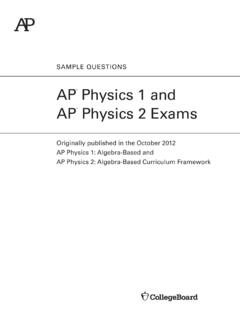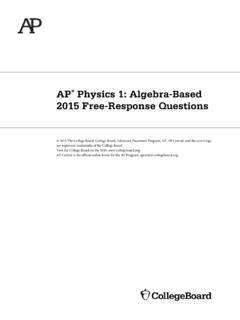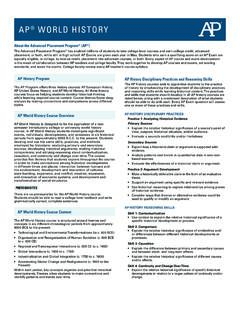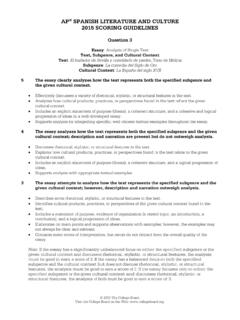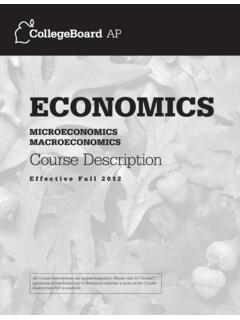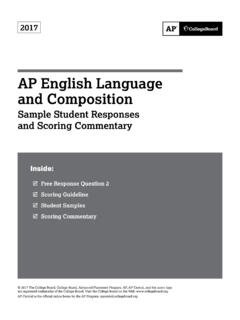Transcription of AP Physics 2: Algebra-Based 2015 Free-Response Questions
1 AP Physics 2: Algebra-Based 2015 Free-Response Questions 2015 The College Board. College Board, Advanced Placement Program, AP, AP Central, and the acorn logo are registered trademarks of the College Board. Visit the College Board on the Web: AP Central is the official online home for the AP Program: AP Physics 2 TABLE OF INFORMATION-2- CONSTANTS AND CONVERSION FACTORS Proton mass, 10 kgpm Neutron mass, 10 kgnm Electron mass, 10 kgem Avogadro s number,23 10 molN Universal gas constant, J (molK)R Boltzmann s constant, 10 J KBk Electron charge magnitude, 10 Ce 1 electron volt, 191 eV 10 J Speed of light, 10 m sc Universal gravitational constant,11 3 10 m kgsG Acceleration due to gravityat Earth s surface, m sg 1 unified atomic mass unit,2721 u 10 kg 931 MeVc Planck s constant, 10 Js 10 eVsh 10 J m 10 eVnmhc Vacuum permittivity,12 2 10 C N me Coulomb s law constant,922014 10 Nm Ckpe Vacuum permeability,70410 (Tm)Amp Magnetic constant, 704 1 10 (T m)
2 Akmp 1 atmosphere pressure,52 51 atm 10 N m 10 Pa C UNIT SYMBOLS meter, mkilogram, kgsecond, sampere, Akelvin, Kmole, molhertz, Hznewton, Npascal, Pajoule, Jwatt, Wcoulomb, Cvolt, Vohm,henry, Hfarad, Ftesla, Tdegree Celsius,Welectron volt, eV PREFIXESF actorPrefixSymbol1210teraT910gigaG610meg aM310kilok210 centic310 millim610 micro m910 nanon1210 picopVALUES OF TRIGONOMETRIC FUNCTIONS FOR COMMON ANGLES q0 30 37 45 53 60 90 sinq01235 2245 321 cosq13245 2235 12 0 tanq033 341 43 3 The following conventions are used in this exam. I. The frame of reference of any problem is assumed to be inertial unless otherwise stated. II. In all situations, positive work is defined as work done on a The direction of current is conventional current.
3 The direction in whichpositive charge would Assume all batteries and meters are ideal unless otherwise Assume edge effects for the electric field of a parallel plate capacitor unless otherwise For any isolated electrically charged object, the electric potential isdefined as zero at infinite distance from the charged object -3- AP Physics 2 EQUATIONS MECHANICS ELECTRICITY AND MAGNETISM 0xxxat 20012xxxt at x 2202xxxax x 0netFFamm fnFFm 2car pmv pFtDD 212 Kmv cosEW FdFdqD EPtDD 20012ttqqwa 0twwa coscos 2xAtAw ftpiicmimxxm netIItta sinrF rFtqA LIw LttDD 212 KIw sFkx a = acceleration A = amplitude d = distance E = energy F = force f = frequency I = rotational inertia K = kinetic energy k = spring constant L = angular momentum = length m = mass P = power p = momentum r = radius or separation T = period t = time U = potential energy v = speed W = work done on a system
4 X = position y = height a = angular acceleration m = coefficient of friction q = angle t = torque w = angular speed 212sUkx gUmgyDD 21 Tfpw 2smTkp 2pTgp 122gmmFGr gFgm 12 GGm mUr 122014 EqqFrpe EFEq 2014qErpe EUqVDD 014qVrpe VErDD QVCD 0 ACdke 0 QEAe 21122 CUQVCD VDQItDD RAr PIVD VIRD siiRR 11piiRR piiCC 11siiCC 02 IBrmp A = area B = magnetic field C = capacitance d = distance E = electric field e = emf F = force I = current = length P = power Q = charge q = point charge R = resistance r = separation t = time U = potential (stored) energy V = electric potential v = speed k = dielectric constant r = resistivity q = angle F = flux MFqvB sinMFqv Bq MFIB sinMFI Bq BBAF cosBBAqF BteDFD Bve AP Physics 2 EQUATIONS -4- FLUID MECHANICS AND THERMAL Physics WAVES AND OPTICS vfl cn 1122sinsinnnqq M = magnification 111ioss f iioohsMhs LmlD sindmql d = separation f = frequency or focal length h = height L = distance m = an integer n = index of refraction s = distance v = speed l = wavelength q = angle GEOMETRY AND TRIGONOMETRY mVr FPA 0PP ghr bFVr g11 22A vAv 211 1222 2121 2 Pgy vPgyrrrr v kA TQtLDD BPVnRTNk T 32 BKkT WPVD UQWD A = area F = force h =
5 Depth k = thermal conductivity K = kinetic energy L = thickness m = mass n = number of moles N = number of molecules P = pressure Q = energy transferred to a system by heating T = temperature t = time U = internal energy V= volume v = speed W = work done on a system y = height r = density MODERN Physics Ehf maxKhff hpl 2 Emc E = energy f = frequency K = kinetic energy m = mass p = momentum l= wavelength f= work function Rectangle Abh Triangle 12Ab h Circle 2 Arp 2 Crp Rectangular solid Vwh Cylinder 2 Vrp 222Sr rpp Sphere 343 Vrp 24 Srp A = area C = circumference V = volume S = surface area b = base h = height = length w = width r = radius Right triangle 22cab 2 sinacq cosbcq tanabq cab90 q 2015 AP Physics 2 Free-Response Questions 2015 The College Board.
6 Visit the College Board on the Web: GO ON TO THE NEXT PAGE. -5- Physics 2 Section II 4 Questions Time 90 minutes Directions: Questions 1 and 4 are short Free-Response Questions that require about 20 minutes each to answer and are worth 10 points each. Questions 2 and 3 are long Free-Response Questions that require about 25 minutes each to answer and are worth 12 points each. Show your work for each part in the space provided after that part. 1. (10 points - suggested time 20 minutes) The figure above shows a cross section of a drinking glass (index of refraction ) filled with a thin layer of liquid (index of refraction ). The bottom corners of the glass are circular arcs, with the bottom right arc centered at point O.
7 A monochromatic light source placed to the right of point P shines a beam aimed at point O at an angle of incidence q. The flat bottom surface of the glass containing point P is frosted so that bright spots appear where light from the beam strikes the bottom surface and does not reflect. When 1q q, two bright spots appear on the bottom surface of the glass. The spot closer to point P will be referred to as X; the spot farther from P will be referred to as Y. The location of spot X and that of spot Y both change as q is increased. (a) In a coherent paragraph-length answer, describe the processes involved in the formation of spots X and Y when 1q q. Include an explanation of why spot Y is located farther from point P than spot X is and what factors affect the brightness of the spots.
8 2015 AP Physics 2 Free-Response Questions 2015 The College Board. Visit the College Board on the Web: GO ON TO THE NEXT PAGE. -6- (b) When q is increased to 2q, one of the spots becomes brighter than it was before, due to total internal reflection. i. On the figure below, draw a ray diagram that clearly and accurately shows the formation of spots X and Y when 2q q. ii. Which spot, X or Y, becomes brighter than it was before due to total internal reflection? Explain your reasoning. (c) When q is further increased to 3q, one of the spots disappears entirely. i. On the figure below, draw a ray diagram that clearly and accurately shows the formation of the remaining spot, X or Y, when 3q q. ii. Indicate which spot, X or Y, disappears.
9 Explain your reasoning in terms of total internal reflection. 2015 AP Physics 2 Free-Response Questions 2015 The College Board. Visit the College Board on the Web: GO ON TO THE NEXT PAGE. -7- 2. (12 points, suggested time 25 minutes)A battery of emf e and negligible internal resistance, three identical incandescent lightbulbs, and a switch S that is initially open are connected in the circuit shown above. The bulbs each have resistance R. Students makepredictions about what happens to the brightness of the bulbs after the switch is closed. (a) A student makes the following prediction about bulb 1: Bulb 1 will decrease in brightness when the switchis closed. i. Do you agree or disagree with the student s prediction about bulb 1 ?
10 Qualitatively explain the switch is closed, the power expended by bulb 1 is 1P. Derive an expression for the powernewP expended by bulb 1 after the switch is closed in terms of How does the result of your derivation in part (a)ii relate to your explanation in part (a)i?(b) A student makes the following prediction about bulb 2: Bulb 2 will decrease in brightness after the switch is closed. i. Do you agree or disagree with the student s prediction about bulb 2 ? Explain your reasoning in Justify your explanation with a calculation.(c) While the switch is open, bulb 3 is replaced with an uncharged capacitor. The switch is then closed. does the brightness of bulb 1 compare to the brightness of bulb 2 immediately after the switchis closed?
